WHERE MONEY IN YOUR CHECKING ACCOUNT GOES
The cost of producing and delivering paper checks is very expensive and can be
disturbed by bad weather and other unexpected events. For example, the terrorist
attacks of 9/11/2001 resulted in the air transportation for the distribution of
paper checks to come to complete halt.
The ability for consumers to make electronic payments has been an available
option for some time. The Federal Reserve has only recently began making a
concentrated effort towards the electronic conversion of checks. Consequently,
consumers are being hit with more fees than ever for using their checking
accounts.
These fees as well as the cost of using debit cards can make it hard to keep
tabs on how much money you have in your account. This can result in you bouncing
checks or overdrafting your account.
Outlined below are some of the common ways money leaves your checking
account. Knowing when and where your money goes will help you be more fiscally
responsible.
Paper check
The use of paper checks is declining, according to the Federal Reserve.However, paper checks still result in over $60 million in payments annually.
The typical route of a check is one that crosses the country by common land
and/or air carriers until it arrives at its target bank and is either returned
back to you or stored.
Check conversion
Whenever a payment is made in a store with a check, it is typically converted
into an electronic image. The information from the check is amassed and a
one-time fee is subtracted from your account. At the conclusion of your
purchase, your check will be run through a machine, voided, and given back to
you. This procedure is commonly known as a point-of-purchase transaction. When
you mail a check in as a payment, an electronic image is created and the check
is destroyed. This sort of electronic debit is also known as an ‘accounts
receivable conversion’, or ARC.
Direct payment
A direct payment is for bills you pay every month, otherwise known as
recurring bills. Usually, you will set your checking account up to make
automatic monthly payments for your mortgage, auto loan, utility bill, etc..
Many people even use direct payment for making contributions towards investment
plans. These types of payments will be marked as an ACH payment on your
statement. Your bank will charge you a one-time fee for every direct payment you
set-up.
Debit card
The use of debit cards has increased over the last few years. In fact, debit
card transaction are the fastest growing types of all bank transactions — from
9.5 billion in 2000 to 32 billon in 2006. Debit cards are most commonly used to
withdraw cash from bank machines, ATMs, by means of a personal identification
number (PIN), but can also be used in the same manner as a credit card for
making purchases. Users will be charged a fee every time they use their debit
card at the ATM or when they make a purchase.


